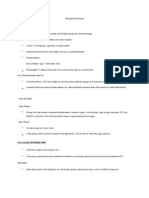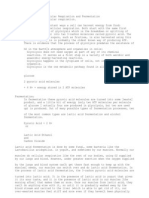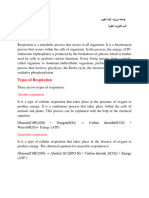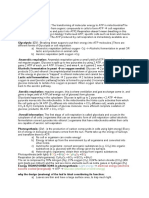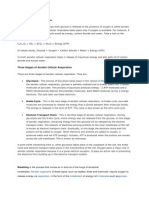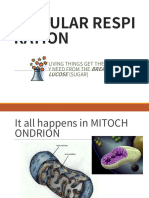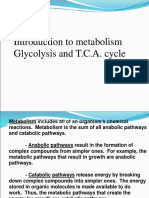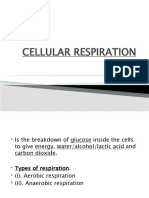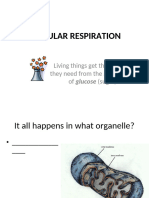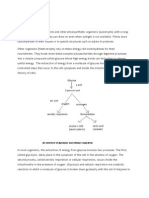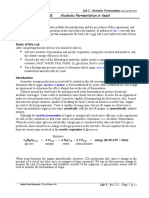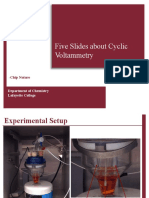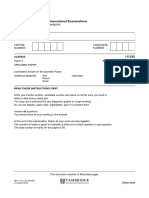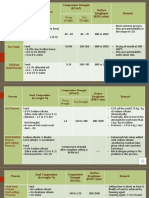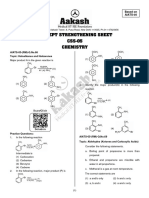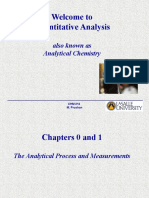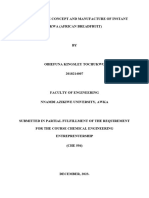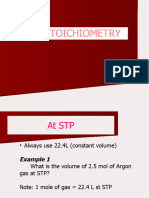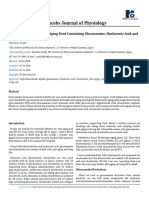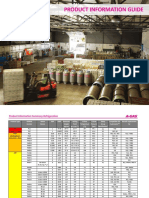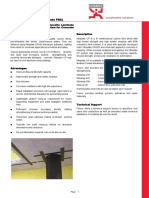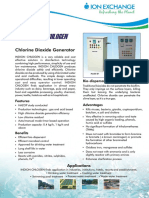RESPIRATION
RESPIRATION
Uploaded by
NopeCopyright:
Available Formats
RESPIRATION
RESPIRATION
Uploaded by
NopeOriginal Description:
Copyright
Available Formats
Share this document
Did you find this document useful?
Is this content inappropriate?
Copyright:
Available Formats
RESPIRATION
RESPIRATION
Uploaded by
NopeCopyright:
Available Formats
RESPIRATION IN PLANTS
Respiration in plants is similar to that in animal, however unlike animals, plants have no special
respiratory organs. Oxygen is taken in and carbon dioxide is given out, through openings in
their leaves and stems called stomata and lenticels respectively.
During the day when the guard cells are open, oxygen and other gases of the atmosphere diffuse
through the stomata into the sub-stomatal air space inside the leaf, and into the inter-cellular
spaces inside the leaf. There the gases come in contact with the cells of the leaf. The surfaces of
these cells within the leaf are the respiratory surfaces. They are moist and through them
oxygen diffuses into the cells, while carbon dioxide diffuses out. High temperature, which brings
with it excessive evaporation and loss of turgor of the guard cells, will cause the stomata to close
(Darkness also brings about a similar effect to high temperatures).
Lenticels do not open and close like stomata; they remain open all the time. The structure of
lenticel is such that the opening is filled with loose cork-cells, which reduce the loss of water
from the cell through the lenticel. Gases from the air diffuse into the stem through the lenticels.
Inside the plant they come in contact with the living cells. Oxygen diffuses into the cells carbon
dioxide diffuses out.
TYPES OF RESPIRATION
There are two types of respiration:
(1) Aerobic and;
(2) Anaerobic Respiration.
Aerobic Respiration
Aerobic respiration occurs in two stages: external (breathing) and internal (cellular/ tissue)
stages. The external stage involves the use of the body organs to facilitate gaseous exchange
while the internal occurs inside the cells. The respiratory system carries out the function of
taking oxygen into the body and giving out carbon dioxide and water vapour.
In aerobic respiration, oxygen is required to breakdown glucose into water, carbon dioxide
and energy (ATP).
Cellular respiration
Cellular respiration involves the activities of the cells in which glucose is broken down by a
series of reactions controlled by enzymes to release energy. The energy so released is stored
in Adenosine Triphosphate (ATP). ATP is the form in which energy is carried, stored and used
by all living cells for the various metabolic processes.
These reactions are very complex but are usually represented by these two simple equation:
Glycolysis (splitting of glucose)
Glycolysis is the series of reactions in respiration by which glucose is broken down to
pyruvic acid in the cytoplasm. Glycolysis occurs in the cytoplasm of living cells and very
little energy is released during glycolysis. A net formation of 2ATPs are produced from
complete oxidation of one glucose molecule during glycolysis. Oxygen is needed to further
breakdown the pyruvic acid produced. Glucose goes through glycolysis, whether the
respiration is aerobic or anaerobic.
This process is represented by the following equation:
glucose pyruvic acid
C6H12O6 → 2C2H3OCOOH + 2H2 + Energy
After glycolysis, the pattern of the second half of tissue respiration depends on whether the
respiration is aerobic or anaerobic (that is, what happens to the pyruvic acid depends on
whether oxygen is present or not).
In aerobic respiration, pyruvic acid goes through a series of reactions known as Kreb’s cycle or
tricarboxylic acid cycle. These reactions take place in the mitochondria which are found in the
cytoplasm of the cells.
Hydrogen ions which are released at various points along the Kreb’s cycle are passed through the
electron transport chain. The reaction produces large amount of energy, which is stored in the
form of ATP. Unlike glycolysis, which yields a net ATPs of two, Kreb’s cycle alone
produces a net ATPs of 36 (36 ATP molecules). The hydrogen ions are finally combined
chemically with oxygen and water.
2C2H3OCOOH + 2H2 + 3O2 → 6CO2 + 6H2O +
Energy
Aerobic respiration (including the initial Glycolysis stage) can be summarized as follows:
Glucose oxygen carbon dioxide water energy
C6H12O6 + 6O2 → 6CO2 + 6H2O + 2880 kJ
The total ATP output from one molecule of glucose is 38 ATP molecules.
Anaerobic respiration
Anaerobic respiration is the type of respiration which does not require the presence of
oxygen to provide energy. When oxygen is absent, the pattern of anaerobic respiration, after
glycolysis, depends on the organism involved. For example:
a) Fermentation
Fermentation is the anaerobic breakdown of sugary liquids to alcohol and a little energy by
micro-organisms such as yeast, with the evolution of carbon dioxide gas. This is a special case of
anaerobic respiration.
2C2H3OCOOH + 2H2 → 2C2H5OH + 2CO2 + Energy
Anaerobic respiration leading to fermentation (including the initial Glycolysis stage) can be
summarized as follows:
glucose ethanol carbon dioxide energy
C6H12O6 → 2C2H5OH + 2CO2 + 210 kJ
b) Lactic acid formation
This occurs in some bacteria which live in anaerobic habitats such as the bottom of ponds and
seas. It also occurs in the muscles of man during strenuous exercises. During such exercises,
enough oxygen is not supplied to the exercising muscles for the complete oxidation of
glucose to release carbon dioxide, water and energy. Instead, lactic acid and a little energy
are released. As the lactic acid accumulates, the increase in the level of acidity in the
muscles causes muscle fatigue and cramps.
These processes can be summarized as follows:
2C2H3OCOOH + 2H2 → 2C2H5OCOOH + Energy
Anaerobic respiration leading to lactic acid formation (including the initial Glycolysis stage) can
be summarized as follows:
glucose lactic acid energy
C6H12O6 → 2C3H6O3 + 150 kJ
Lactic acid is a mild poison in our muscles and must be gotten rid of. This is done by breaking it
down into carbon dioxide and water. Oxygen is needed for this, and that is why we pant
immediately after a race. The oxygen required to get rid of the lactic acid is called the oxygen
debt.
Note that only about 2 molecules of ATP are released from the breakdown of one glucose
molecule during anaerobic respiration.
Comparison of aerobic and anaerobic respiration
Aerobic respiration Anaerobic respiration
Oxygen is essential Oxygen is not essential
More energy is released than in anaerobic Less energy is released than in aerobic respiration
respiration
Waste products are carbon dioxide and water Waste products are ethanol and carbon dioxide in
plant cells, lactic acid in animal cells
It takes place in the mitochondria. It takes place in the cytoplasm.
You might also like
- CAGI Compresed Air HandbookDocument757 pagesCAGI Compresed Air Handbookhidrastar123100% (8)
- Envair Incubators-CO2 HF240 90 ManualDocument41 pagesEnvair Incubators-CO2 HF240 90 ManualJulian JecovNo ratings yet
- Cellular RespirationDocument3 pagesCellular Respirationchideraangelg5fNo ratings yet
- Respiration in PlantsDocument3 pagesRespiration in PlantsaarushpancholiNo ratings yet
- Cellular RespirationDocument15 pagesCellular RespirationgailoreventerNo ratings yet
- Production of Energy in Biological SystemDocument18 pagesProduction of Energy in Biological Systemutsav872006No ratings yet
- Photosynthesis and Cellular Respiration SummaryDocument5 pagesPhotosynthesis and Cellular Respiration Summarylady ann jimenez100% (1)
- Gen Bio 1 L4 Respiration Aerobic and AnaerobicDocument23 pagesGen Bio 1 L4 Respiration Aerobic and AnaerobicMAF FormilosNo ratings yet
- Respiration PowerpointDocument14 pagesRespiration Powerpointmmpanjwani4No ratings yet
- Class 11 - Biology - Respiration in PlantsDocument13 pagesClass 11 - Biology - Respiration in PlantsDivyansheeNo ratings yet
- Cellular Respiration Is A Set of Metabolic Reactions and Processes That TakeDocument8 pagesCellular Respiration Is A Set of Metabolic Reactions and Processes That TakeashNo ratings yet
- Aerobic RespirationDocument10 pagesAerobic RespirationimanyiyadahNo ratings yet
- Topic 6B Agr3101Document31 pagesTopic 6B Agr3101Sleeping BeautyNo ratings yet
- Photosynthesis and Respiration NotesDocument1 pagePhotosynthesis and Respiration NotesjazsloanNo ratings yet
- Respiration Is of Two TypesDocument3 pagesRespiration Is of Two TypesKyng GamariNo ratings yet
- Lec 9 Energy of LifeDocument29 pagesLec 9 Energy of LifeFahim AbidNo ratings yet
- Summary of Cellular RespirationDocument4 pagesSummary of Cellular RespirationchiomasingsNo ratings yet
- 8-C1.2 Cell RespirationDocument47 pages8-C1.2 Cell Respirationmakaya02No ratings yet
- 1.4 RespirationDocument11 pages1.4 RespirationPema GaleyNo ratings yet
- Cellular RespirationDocument6 pagesCellular RespirationBrian Reyes GangcaNo ratings yet
- Lab.3 PhysicsDocument4 pagesLab.3 Physicsksoo5118No ratings yet
- PBT-REVIEWER-PREFINALDocument4 pagesPBT-REVIEWER-PREFINALynamaye08No ratings yet
- Biology 2.1: Electrical Energy (Electrons Become Excited (Energised) )Document3 pagesBiology 2.1: Electrical Energy (Electrons Become Excited (Energised) )Sel 7No ratings yet
- Las Q4 WK3.1Document8 pagesLas Q4 WK3.1Perlyn Del Pilar OduyaNo ratings yet
- Aerobic Cellular RespirationDocument3 pagesAerobic Cellular RespirationlutherlynNo ratings yet
- Periodic Term III NotesDocument22 pagesPeriodic Term III Notessm2524363No ratings yet
- Cellular Respiration PPT Martinez 1Document36 pagesCellular Respiration PPT Martinez 1merjorie012006No ratings yet
- RespirationDocument16 pagesRespirationlayalirsNo ratings yet
- Cellular RespirationDocument11 pagesCellular RespirationNiña Jennifer Potter Vergara100% (2)
- Slide 1Document1 pageSlide 1NickTheTurtleNo ratings yet
- Introduction To Metabolism Glycolysis and T.C.A. CycleDocument23 pagesIntroduction To Metabolism Glycolysis and T.C.A. Cycleمحمد جانNo ratings yet
- Lec 11,12 Energy of Life RMDocument9 pagesLec 11,12 Energy of Life RMEnmuskNo ratings yet
- Celluar RespirationDocument16 pagesCelluar Respirationpetra.t.ayalNo ratings yet
- Chapter -14 Respiration in Plants_watermarkDocument17 pagesChapter -14 Respiration in Plants_watermarkshrivastavvaibhav548No ratings yet
- Cellular Respiration NotesDocument10 pagesCellular Respiration Notescsujithan100% (1)
- C6H12O6 + 6O2 - 6CO2 + 6H2O +ATP: RespirationDocument2 pagesC6H12O6 + 6O2 - 6CO2 + 6H2O +ATP: RespirationHarleen BalNo ratings yet
- Chapter 12 ContentDocument16 pagesChapter 12 Contentkevenliamwilliam.exampointNo ratings yet
- Gen Bio Reviewer 2nd QuarterDocument6 pagesGen Bio Reviewer 2nd QuarterauroraroderosNo ratings yet
- 2.8 Cell Respiration SL: Chapter 2 Molecular Biology p.98-103Document46 pages2.8 Cell Respiration SL: Chapter 2 Molecular Biology p.98-103PaolaNo ratings yet
- CellRespi 2Document21 pagesCellRespi 2Nudiya SappalNo ratings yet
- Cream and Green Illustrative Science Project PresentationDocument29 pagesCream and Green Illustrative Science Project PresentationCaitlin TishNo ratings yet
- 06 - BIO IX ICSE Respiration in PlantsDocument7 pages06 - BIO IX ICSE Respiration in PlantsAyush ShindeNo ratings yet
- RespirationDocument6 pagesRespirationfaithdanielleyNo ratings yet
- Topic 9 - Cellular RespirationDocument35 pagesTopic 9 - Cellular RespirationJasmine SucalitNo ratings yet
- 5 - Lab 5 - Alc Ferm in Yeast - F2009Document15 pages5 - Lab 5 - Alc Ferm in Yeast - F2009Odhiambo HenryNo ratings yet
- Cellular Respiration: Chemical Bonds GlucoseDocument10 pagesCellular Respiration: Chemical Bonds Glucosemegamega11No ratings yet
- Introduction To RespirationDocument14 pagesIntroduction To RespirationAzneezal Ar-RashidNo ratings yet
- 4. Fermentation and anaerobicDocument4 pages4. Fermentation and anaerobicAlvin NyagaNo ratings yet
- General Biology 1 Las Aeroboc RespirationDocument6 pagesGeneral Biology 1 Las Aeroboc Respirationkevinbrentd30No ratings yet
- Photosynthesis and Cellular Respiration PostDocument28 pagesPhotosynthesis and Cellular Respiration PostJerielita MartirezNo ratings yet
- Jinnah University For Women: Group Members: Javeria Shahzad Kanza Naseer Muqaddas Raees Zainab GhufranDocument13 pagesJinnah University For Women: Group Members: Javeria Shahzad Kanza Naseer Muqaddas Raees Zainab GhufranDEVIL GAMINGNo ratings yet
- An Overview of Glycolysis and Cellular RespirationDocument8 pagesAn Overview of Glycolysis and Cellular Respirationabdulrehman999No ratings yet
- Presentation 5Document15 pagesPresentation 5Rahanie Gadungan PajijiNo ratings yet
- GR 11 LS Cellular Respiration NotesDocument5 pagesGR 11 LS Cellular Respiration Notestshidinaomi5No ratings yet
- RespirationDocument3 pagesRespirationKhadijah HabeebahNo ratings yet
- Lab 5 Alcoholic Fermentation in YeastDocument15 pagesLab 5 Alcoholic Fermentation in YeastFilipe GoncalvesNo ratings yet
- Cellular Respiration in PlantsDocument33 pagesCellular Respiration in PlantsMARK BRIAN FLORESNo ratings yet
- Cellular RespirationDocument10 pagesCellular RespirationXavier LecarosNo ratings yet
- B1.2a Respiration - 2018Document37 pagesB1.2a Respiration - 2018Wayne DayataNo ratings yet
- Grade 11: Modified Strategic Intervention MaterialDocument19 pagesGrade 11: Modified Strategic Intervention MaterialJake LacanlaleNo ratings yet
- Cellular RespirationDocument27 pagesCellular Respirationglatic.pyxNo ratings yet
- Five Slides About Cyclic Voltammetry: - Chip NataroDocument18 pagesFive Slides About Cyclic Voltammetry: - Chip NataromayankbishtNo ratings yet
- MIL-W-8604 - A (Welding, Fusion Aluminum Alloys Process and Performance Of)Document20 pagesMIL-W-8604 - A (Welding, Fusion Aluminum Alloys Process and Performance Of)ccorp0089No ratings yet
- Car Wrap Vinyl Catalog (2024-07-09 18 - 10 - 18)Document6 pagesCar Wrap Vinyl Catalog (2024-07-09 18 - 10 - 18)Kamba AngelNo ratings yet
- V-Flon #200 Clean Primer: Product Data SheetDocument2 pagesV-Flon #200 Clean Primer: Product Data SheetArun StarlightNo ratings yet
- Science Class 10 Complete BooksDocument76 pagesScience Class 10 Complete BooksTemsuyanger JamirNo ratings yet
- AE Board Recalled Question Part 3 Rural Electrification and Allied Subjects9Document3 pagesAE Board Recalled Question Part 3 Rural Electrification and Allied Subjects9Nell Cathlyn EspañolaNo ratings yet
- CHEM110-Spring 2021 - 2022-Experiment 3Document14 pagesCHEM110-Spring 2021 - 2022-Experiment 3bm7gyygjtfNo ratings yet
- Skoog Fac 10e Sag Ch08Document16 pagesSkoog Fac 10e Sag Ch08u112021140No ratings yet
- Science Specimen Paper 2 2015Document16 pagesScience Specimen Paper 2 2015Akhilesh Maurya [USG]No ratings yet
- Ana A: Brevet Canadien Canadian Patent CDocument26 pagesAna A: Brevet Canadien Canadian Patent Cchriskpchan8No ratings yet
- Sulfamic AcidDocument4 pagesSulfamic AcidAzizNo ratings yet
- Compressive Strength (kN/m2) Surface Roughness (RMS Value) RemarkDocument5 pagesCompressive Strength (kN/m2) Surface Roughness (RMS Value) RemarksumeetNo ratings yet
- Concept Strengthening Sheet (CSS-05) Based On AIATS-05 (RM) - ChemistryDocument5 pagesConcept Strengthening Sheet (CSS-05) Based On AIATS-05 (RM) - ChemistryAyush SharmaNo ratings yet
- Pliobond 25 4018903 GB-En v2 0-KonverteretDocument12 pagesPliobond 25 4018903 GB-En v2 0-KonverteretaljadNo ratings yet
- Welcome To Quantitative Analysis: Also Known As Analytical ChemistryDocument28 pagesWelcome To Quantitative Analysis: Also Known As Analytical ChemistryPrincess Angie GonzalesNo ratings yet
- Tab&sachetDocument4 pagesTab&sachetSann SeyhaNo ratings yet
- AM HistoryQuartzOscillatorPlateIndustry1941-1944 Frondel1945Document9 pagesAM HistoryQuartzOscillatorPlateIndustry1941-1944 Frondel1945LeandroNo ratings yet
- AMV Common IssuesDocument35 pagesAMV Common Issuesadham hatawiNo ratings yet
- African Breadfruit Popular Known As UkwaDocument3 pagesAfrican Breadfruit Popular Known As UkwaCharles ObiefunaNo ratings yet
- High Performance Thermoplastics: Materials, Properties and ApplicationsDocument40 pagesHigh Performance Thermoplastics: Materials, Properties and ApplicationsbrotherNo ratings yet
- Gas StoichiometryDocument17 pagesGas StoichiometryJamless ChimChimNo ratings yet
- Secret of Anti-Aging Anti-Aging Food ConDocument5 pagesSecret of Anti-Aging Anti-Aging Food ConSusanaNo ratings yet
- A3.03 Specifications of Food AdditivesDocument27 pagesA3.03 Specifications of Food AdditivesBesian OsmaniNo ratings yet
- Refrigerant Product Guide 7277 Option1 For WebDocument3 pagesRefrigerant Product Guide 7277 Option1 For Webkin hung chanNo ratings yet
- TDS Nitoplate CP SEADocument4 pagesTDS Nitoplate CP SEASefta MegaNo ratings yet
- EFFECT OF WOOD ASHES ON FRESH AND HARDENED CEMENT PASTE (Onarıldı)Document23 pagesEFFECT OF WOOD ASHES ON FRESH AND HARDENED CEMENT PASTE (Onarıldı)ihtishamNo ratings yet
- 3rd Q Physical ScienceDocument6 pages3rd Q Physical ScienceViktor InocNo ratings yet
- Chlogen: Chlorine Dioxide GeneratorDocument2 pagesChlogen: Chlorine Dioxide GeneratorArunNo ratings yet






